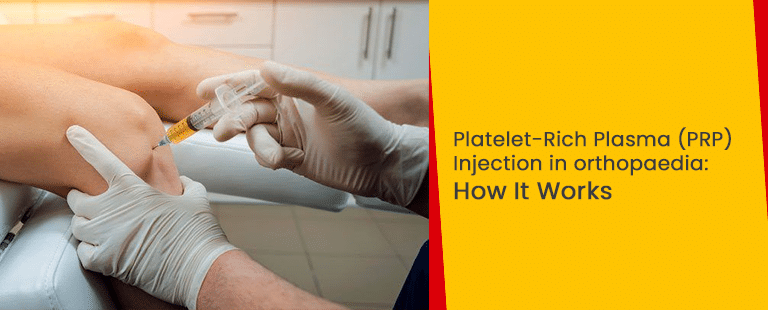PRP Injection Treatment
Platelet-Rich Plasma (PRP) Injection in orthopaedia: How It Works
The liquid component of blood is called plasma. Composed of nutrients, antibodies, proteins, and glucose, plasma is the medium through which the red and white blood cells, along with other material, travel through the bloodstream. Platelets are also a component of blood. The job of platelets is to secrete proteins and other growth factors that help maintain cell division, promote healing and tissue regeneration. Apart from this, platelets also assist the blood in clotting.
What is Platelet-rich Plasma (PRP)?
Platelet-rich plasma is plasma with more platelets than the concentration normally found in the blood. To prepare platelet-rich plasma, blood is drawn from the patient. From this blood sample, the platelets are separated from other blood cells. After this, a process called centrifugation is performed to increase the concentration of growth factors.
What is PRP therapy?
Platelet-rich plasma therapy is a form of regenerative medicine, wherein the blood’s natural healing properties are utilized. The healing solution is made by the above-mentioned procedure and is injected into the body at the point of injury. When the injected growth factors interact with local cells, these cells get triggered to begin healing the injury. Inflammation is reduced and tissue formation is also promoted, with this therapy.
Where can PRP therapy be used?
Platelet-rich plasma therapy can be applied for various purposes, such as:
- Acute injuries – PRP injections can be used to treat acute sports injuries such as knee sprains or pulled hamstring muscles.
- Tendon injuries – Tendon injuries such as tennis elbow, Achilles tendonitis, and jumper’s knee can heal very slowly, but PRP injections have been used to treat the same.
- Osteoarthritis – Traditionally, hyaluronic acid injections are used for treating osteoarthritis but studies have shown that PRP injections were more effective as compared to them. However, for definitive conclusions, more studies need to be conducted.
- Hair loss – PRP injections have been effective in treating male pattern baldness. PRP is injected into the scalp to prevent hair loss and promote hair growth.
How is PRP therapy used in Orthopaedics?
According to research, PRP therapy has been an effective form of treatment when conventional methods such as physical therapy, surgery, cortisone injections, or anti-inflammatories have failed to work. Many orthopedic conditions such as rotator cuff tears, tendonitis, arthritis, golfer’s elbow, tennis elbow, Achilles tendon ruptures, and soft-tissue injuries can be treated using PRP therapy.
PRP injection process
PRP therapy is a fairly simple procedure. First, the healthcare professional draws a sample of your blood. The amount of blood to be drawn depends upon the area of PRP injection. After this, the blood is placed into a machine called a centrifuge. The machine spins at a high speed such that the components of blood get separated. This process takes around 15 minutes. After this, a technologist will take the separated plasma and prepare it for injection. To pinpoint the exact area where PRP is to be injected, the doctor might perform imaging tests such as an ultrasound. After this, the PRP is injected into the affected area. The complete process takes around one hour.
Side effects of PRP therapy
Since PRP is injected directly into the skin, there may be a few side effects such as:
- Nerve injuries
- Tissue damage
- Infection
- Pain at the injection site
The risk of an allergic reaction is low since the body’s own substances are being injected directly.
Recovery time for PRP injections
It is recommended by doctors that after PRP injections, one should rest the area in question. Most people can continue their daily activities after PRP injections. The instructions given to you will be more related to your injury rather than the injection.
You may not notice an immediate difference, post taking the injection. It might take several weeks or months for the area to heal.
At Germanten Hospital, PRP therapy is used as an alternative for surgery to treat knee pain. Our team of doctors, led by Dr. Mir Jawad Zar Khan, aims to personalize PRP therapy according to each different patient and their injury, to provide the best possible results. Germanten Hospital is NABH accredited and each operation theatre is of class100 level, offering high-advanced laminar airflow for total infection control, with more than 200 beds. In 2019, Times of India graded Germanten Hospital as the Best Emerging Orthopaedic Hospital. It was also named the Best Orthopaedic Hospital in South India, by the Economic Times in 2021. At Germanten Hospital, the most recent, modern, and advanced medical procedures such as PRP are performed, to take orthopedic medicine to the next level.
At the forefront of Germanten Hospital is the renowned orthopedic surgeon, Dr Mir Jawad Zar Khan. A veteran of more than 20 years in the field of orthopedics, he is a gold medalist of Osmania University and has received advanced training from Germany and the USA. To celebrate his achievements and effort, he was awarded the title of Best Doctor by the ex-CM of Joint Andhra Pradesh & Former Governor Tamilnadu, Shri Roshaiah Garu in 2018. In 2019, he was honored with the Vaida Ratna Award by the Honourable Health Minister of Telangana, Shree Etala Rajendra.


